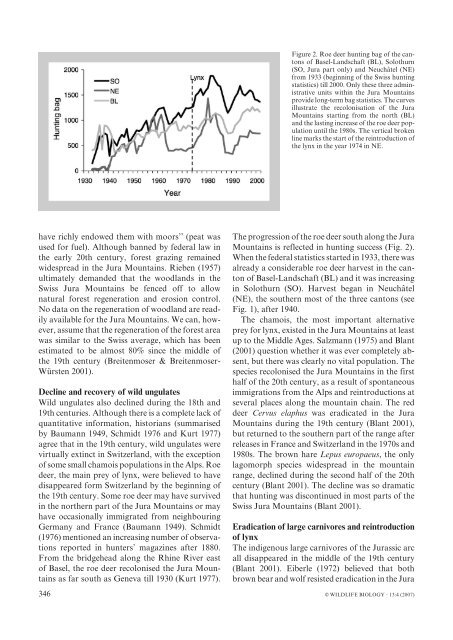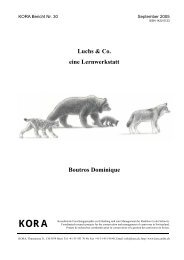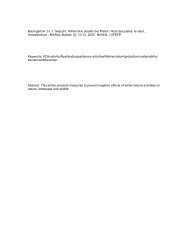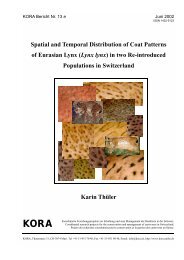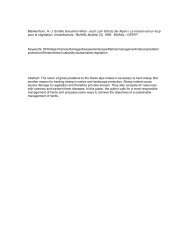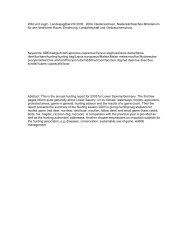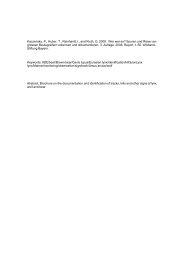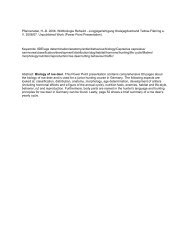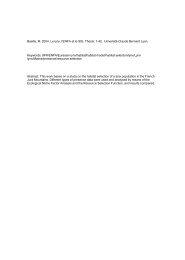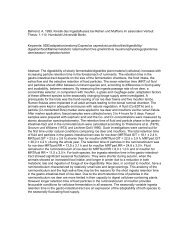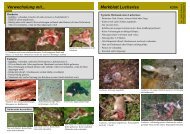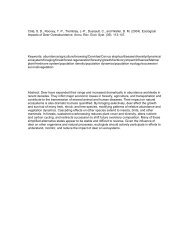Breitenmoser, U., Breitenmoser-Würsten, Ch., Capt, S ... - Kora
Breitenmoser, U., Breitenmoser-Würsten, Ch., Capt, S ... - Kora
Breitenmoser, U., Breitenmoser-Würsten, Ch., Capt, S ... - Kora
Create successful ePaper yourself
Turn your PDF publications into a flip-book with our unique Google optimized e-Paper software.
Figure 2. Roe deer hunting bag of the cantons<br />
of Basel-Landschaft (BL), Solothurn<br />
(SO, Jura part only) and Neuchâtel (NE)<br />
from 1933 (beginning of the Swiss hunting<br />
statistics) till 2000. Only these three administrative<br />
units within the Jura Mountains<br />
provide long-term bag statistics. The curves<br />
illustrate the recolonisation of the Jura<br />
Mountains starting from the north (BL)<br />
and the lasting increase of the roe deer population<br />
until the 1980s. The vertical broken<br />
line marks the start of the reintroduction of<br />
the lynx in the year 1974 in NE.<br />
have richly endowed them with moors’’ (peat was<br />
used for fuel). Although banned by federal law in<br />
the early 20th century, forest grazing remained<br />
widespread in the Jura Mountains. Rieben (1957)<br />
ultimately demanded that the woodlands in the<br />
Swiss Jura Mountains be fenced off to allow<br />
natural forest regeneration and erosion control.<br />
No data on the regeneration of woodland are readily<br />
available for the Jura Mountains. We can, however,<br />
assume that the regeneration of the forest area<br />
was similar to the Swiss average, which has been<br />
estimated to be almost 80% since the middle of<br />
the 19th century (<strong>Breitenmoser</strong> & <strong>Breitenmoser</strong>-<br />
Würsten 2001).<br />
Decline and recovery of wild ungulates<br />
Wild ungulates also declined during the 18th and<br />
19th centuries. Although there is a complete lack of<br />
quantitative information, historians (summarised<br />
by Baumann 1949, Schmidt 1976 and Kurt 1977)<br />
agree that in the 19th century, wild ungulates were<br />
virtually extinct in Switzerland, with the exception<br />
of some small chamois populations in the Alps. Roe<br />
deer, the main prey of lynx, were believed to have<br />
disappeared form Switzerland by the beginning of<br />
the 19th century. Some roe deer may have survived<br />
in the northern part of the Jura Mountains or may<br />
have occasionally immigrated from neighbouring<br />
Germany and France (Baumann 1949). Schmidt<br />
(1976) mentioned an increasing number of observations<br />
reported in hunters’ magazines after 1880.<br />
From the bridgehead along the Rhine River east<br />
of Basel, the roe deer recolonised the Jura Mountains<br />
as far south as Geneva till 1930 (Kurt 1977).<br />
The progression of the roe deer south along the Jura<br />
Mountains is reflected in hunting success (Fig. 2).<br />
When the federal statistics started in 1933, there was<br />
already a considerable roe deer harvest in the canton<br />
of Basel-Landschaft (BL) and it was increasing<br />
in Solothurn (SO). Harvest began in Neuchâtel<br />
(NE), the southern most of the three cantons (see<br />
Fig. 1), after 1940.<br />
The chamois, the most important alternative<br />
prey for lynx, existed in the Jura Mountains at least<br />
up to the Middle Ages. Salzmann (1975) and Blant<br />
(2001) question whether it was ever completely absent,<br />
but there was clearly no vital population. The<br />
species recolonised the Jura Mountains in the first<br />
half of the 20th century, as a result of spontaneous<br />
immigrations from the Alps and reintroductions at<br />
several places along the mountain chain. The red<br />
deer Cervus elaphus was eradicated in the Jura<br />
Mountains during the 19th century (Blant 2001),<br />
but returned to the southern part of the range after<br />
releases in France and Switzerland in the 1970s and<br />
1980s. The brown hare Lepus europaeus, the only<br />
lagomorph species widespread in the mountain<br />
range, declined during the second half of the 20th<br />
century (Blant 2001). The decline was so dramatic<br />
that hunting was discontinued in most parts of the<br />
Swiss Jura Mountains (Blant 2001).<br />
Eradication of large carnivores and reintroduction<br />
of lynx<br />
The indigenous large carnivores of the Jurassic arc<br />
all disappeared in the middle of the 19th century<br />
(Blant 2001). Eiberle (1972) believed that both<br />
brown bear and wolf resisted eradication in the Jura<br />
346 E WILDLIFE BIOLOGY ? 13:4 (2007)


